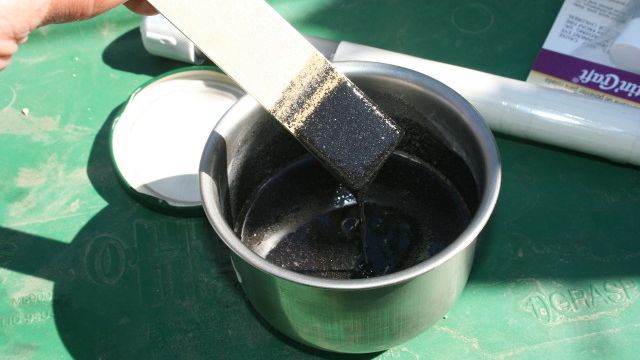Let’s say you’re stranded on a desert island and want to get the news from the outside world. You’ll have to build your own crystal radio, of course, but your parts bin is nowhere to be found and Digi-Key isn’t delivering. So you’ll need to MacGuyver some components. Capacitors are easy with a couple of pieces of tinfoil, and a rectifier can be made from a pencil and a razor blade. But what about an inductor? Sure, air-core inductors will work, but just because you’re marooned doesn’t mean you’ve abandoned your engineering principles. Luckily, you’ve read [AC7ZL]’s treatise of making inductors from dirt, and with sand in abundance, you’re able to harvest enough material to put together some passable ferrite-core inductors.
Obviously, making your own inductive elements isn’t practical even in fanciful and contrived situations, but that doesn’t make the doing of it any less cool. The story begins with a walk in the Arizona desert many years ago, where [AC7ZL], aka [H.P. Friedrichs], spied bands of dark sand shooting through the underlying lighter sediments. These bands turned out to be magnetite, one of many iron-bearing minerals found in the area. Using a powerful magnet from an old hard drive and a plastic food container, he was able to harvest magnetite sand in abundance and refine it with multiple washing steps.
After experimentally determining the material’s permeability — about 2.3 H/m — [AC7ZL] proceeded with some practical applications. He was able to make a bar antenna for an AM radio by packing the sand into a PVC pipe and rewinding the coils around it. More permanent cores were made by mixing the sand with polyester resin and casting it into bars. Toroids were machined from fat bars of the composite on a lathe, much to the detriment of the cutting tools used.
The full-length PDF account of [AC7ZL]’s experiments makes for fascinating reading — the inductive elements he was able to create all performed great in everything from a Joule Thief to a Hartley oscillator up to 27 MHz. We love these kinds of stories, which remind us of some of the work being done by [Simplifier] and others.
















Oh neato, time to revisit Jeri Ellsworth’s magnetic logic work, https://www.youtube.com/watch?v=p7SkE5pERtA
Please fix MacGyver.
+1
Why would you want to neuter him?
Californian beaches have a lot of “Black sand” magnetic too, but mixed in is enough Thorium to make it radioactive. The subject of a Local TV news broadcast, about two years ago, when a person with a Radiation Detection meter claimed it was from Japans Nuke Disaster
Or at least change it to Angus
https://www.youtube.com/watch?v=gUT8doDpBI0
But… but…
Where do you get a piece of tin foil for a capacitor when you’re marooned on a desert island?
if you didn’t arrive via metallic aircraft or boat, perhaps you will be lucky? enough to have an unopened can of diet soda float your way, In a world without the valuable Macgyvering resource known as flotsam, and assuming that you aren’t a foil-packed gum-carrying man named Angus(who would view a half-broken pair of dollar tree headphones as a glass half full in this scenario), your primary concern should be creating fire, with which you can
fabricate pure silicon wafers, hone your lithographic processes, and create microchips tosmelt the resources around you, to obtain metals, maybe make some glass, distill some Dihydrogen Monoxide, and since we are not in a world without flotsam, you can probably expect to find at least one plastic bottle, possibly a glass bottle, and maybe even an empty can of something that managed to survive the journey to your island without capsizing. but couldn’t you just use some wet leaves or slightly moistened salt or mud or sand or pretty much anything conductive, separated by pretty much anything nonmetallic that floats your way, or some of that bubble gum you got your foil from, or some packing tape.. or perhaps, if you have some non-survivors tagging along: The Human Body Model for capacitance, as defined by the Electrostatic Discharge Association (ESDA) is a 100pF capacitor in series with a 1.5kΩ resistor[1].I don’t know about that soda can. Those things seem to be designed for minimum hobbyist re-uasability with some sort of metal/plastic mix that isn’t really enough metal to use for projects requiring metal but also isn’t quite enough plastic to be meltable.
Melting aluminium soda cans is trivial.
They make good shims…
Stashed next to the polyester..
H.P. Friedrichs’ books are a hoot. If he was the professor on Gilligan’s Island the show wouldn’t have lasted a season.
lolwtfm8, having lived on the Big Island I’ve seen the vast amount of rubbish that washes up on the Southern coastline. Volunteers go there and clean it up only to see it just as bad the following year if not sooner. It’s a sad thing to see.
Which Revenge of the Nerds movie had them on a desert island and they made a metal detector?
Totally awesome! I completely missed this article. I’ve been wanting to grind up and see if I can do the same with old ferrite material from salvaged parts. What inspired me was this youtube video:
https://www.youtube.com/watch?v=iXLWu6jSHQU